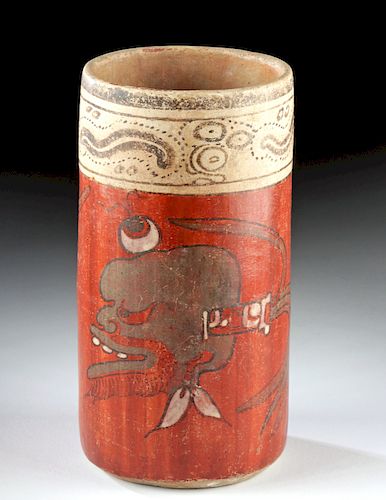Incredible Maya Cylinder - God 'A' and Eyeball
Lot 8
About Seller
Artemis Fine Arts
686 S Taylor Ave, Ste 106
Louisville, CO 80027
United States
Selling antiquities, ancient and ethnographic art online since 1993, Artemis Gallery specializes in Classical Antiquities (Egyptian, Greek, Roman, Near Eastern), Asian, Pre-Columbian, African / Tribal / Oceanographic art. Our extensive inventory includes pottery, stone, metal, wood, glass and textil...Read more
Estimate:
$20,000 - $28,000
Absentee vs Live bid
Two ways to bid:
- Leave a max absentee bid and the platform will bid on your behalf up to your maximum bid during the live auction.
- Bid live during the auction and your bids will be submitted real-time to the auctioneer.
Bid Increments
| Price | Bid Increment |
|---|---|
| $0 | $25 |
| $300 | $50 |
| $1,000 | $100 |
| $2,000 | $250 |
| $5,000 | $500 |
| $10,000 | $1,000 |
| $20,000 | $2,500 |
| $50,000 | $5,000 |
| $100,000 | $10,000 |
| $200,000 | $20,000 |
About Auction
By Artemis Fine Arts
Oct 3, 2019
Set Reminder
2019-10-03 10:00:00
2019-10-03 10:00:00
America/New_York
Bidsquare
Bidsquare : Exceptional Day 2: Pre-Columbian & Tribal Art
https://www.bidsquare.com/auctions/artemis-gallery/exceptional-day-2-pre-columbian-tribal-art-4453
Day 2 of an important 2-day auction featuring exceptional, museum-worthy examples of Pre-Columbian from the ancient Americas, Native American, African / Tribal, Oceanic, Spanish Colonial and fossils. Artemis Fine Arts info@artemisgallery.com
Day 2 of an important 2-day auction featuring exceptional, museum-worthy examples of Pre-Columbian from the ancient Americas, Native American, African / Tribal, Oceanic, Spanish Colonial and fossils. Artemis Fine Arts info@artemisgallery.com
- Lot Description
Pre-Columbian, Southern Mexico to Guatemala, Maya, Late Classic Period, ca. 550 to 900 CE. Wow! With gorgeously preserved bright pigment and striking motifs, this is a ceramic cylinder vessel with rich iconography. It was probably given as a gift during a feast and used for drinking cocoa. It is tall, with a narrow mouth with an unpronounced rim whose edge is gently curved. It stands on a flat base with gently upturned edges and the sides taper very slightly to the mouth. Much of the exterior body is dominated by a boldly painted, black-outlined profile head of God A wearing a disembodied eyeball above his brow against a scarlet background. Feathers extend behind his head in a headdress, signifying his importance. A narrow band around the upper part of the exterior features black glyphoid symbols that resemble eyes and caterpillars, both symbols for the soul, on a background of creamy white. Size: 3.45" W x 7" H (8.8 cm x 17.8 cm)
God A is one of the Maya codical death gods, known to us only from early colonial-era documents and from the work of 19th century scholar Paul Schellas, who named the gods for letters from the Roman alphabet because at the time Maya hieroglyphs could not be read. A figure similar to God A is called by many different names by modern Maya people - often Kimi or Ah Puch - and is the Lord of the Underworld (known variously as Xibalba or Mitnal depending on the dialect). God A is often painted as he is here as partially dead, with grey, decaying flesh and skeletal bone structure. He is meant to be both terrifying and grotesquely funny, and this portrayal, with its askew teeth and bulbous nose, embodies both. Modern Maya folklore still considers God A a threat - creeping around the houses of the sick, waiting to take them to Xibalba.
Residue analysis on vessels like this one show that they were used for drinking chocolate, a hugely popular and ritual practice amongst the Maya, especially the elite. Although we know little about the artisans who made vessels like this one, we do know that cylinder jars are often associated with tombs, sometimes ritually broken. Prominent Mayanist Michael Coe has connected the scenes depicted upon the most important of these vessels with the sixteenth century Maya written epic, the Popol Vuh, which describes Maya religion and mythology, as this one does.
Provenance: ex-private North Carolina, USA collection, acquired in the 1970s
All items legal to buy/sell under U.S. Statute covering cultural patrimony Code 2600, CHAPTER 14, and are guaranteed to be as described or your money back.
A Certificate of Authenticity will accompany all winning bids.
We ship worldwide and handle all shipping in-house for your convenience.
#119408Expertly repaired and restored, which is almost impossible to see. Very limited overpainting, with almost entirely original pigment on the exterior. Motifs are very clear with light deposits.Condition
- Shipping Info
-
All shipping is handled in-house for your convenience. Your invoice from Artemis Gallery will include shipping calculation instructions. If in doubt, please inquire BEFORE bidding for estimated shipping costs for individual items.
-
- Buyer's Premium



 EUR
EUR CAD
CAD AUD
AUD GBP
GBP MXN
MXN HKD
HKD CNY
CNY MYR
MYR SEK
SEK SGD
SGD CHF
CHF THB
THB
















